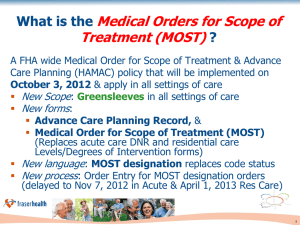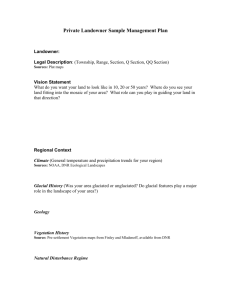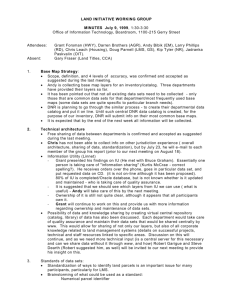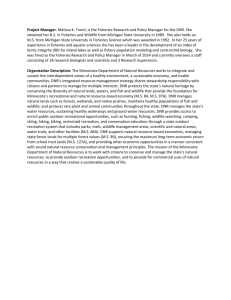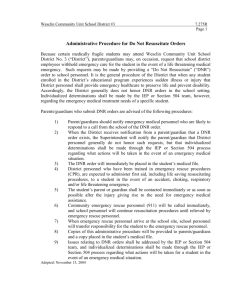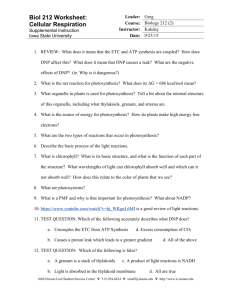The project is on time
advertisement
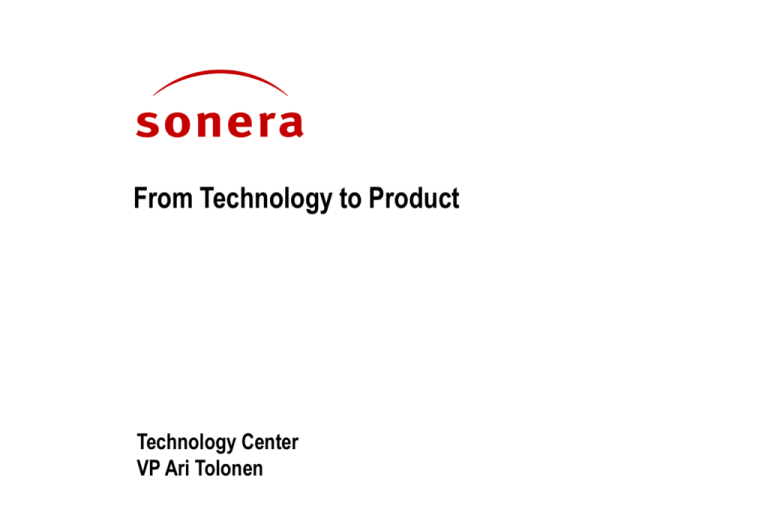
From Technology to Product Technology Center VP Ari Tolonen Change of Environment New software technologies New dynamic market e.g CORBA, JavaBeans, DCOM, Agent technologies e.g shorten product life cycle, new user demands, lifestyles New type of applications e.g multimedia, electronic commerce, communities New generation products and services New development methodologies e.g Object-oriented, frameworks, design patterns, componentware New Technologies and Markets Coverage + Time Market launch Break even Product substitution Demand: Various content through various access Service Applications Billing User profiles Terminals Access network Authenticatio n Authorisation Accounting Content Platform Service platform Content Successful product development project Cornerstones of successful product development according to Dr. Robert Cooper • high quality product development process • product innovation strategy for the business • sufficient and competent R&D resources Of the three, having a high quality product development process had the strongest impact on business’s new product performance Stable Processes Needed in Unstable Markets Stable Market Unstable Market Stable Processes desirable necessary Unstable Processes possible impossible Sonera process map Markkina Markkinaprosessi: Uusien tuotteiden tuottaminen markkinoille ja tuotteiden hallinta Asiakasprosessi: Laadukkaat tuotteet ja asiakassuhteet Asiakkaan tarpeiden tyydyttäminen Johtamisprosessit Tukiprosessit = Soneran yhtiöt ja yksiköt Kilpailukykyiset ratkaisut/ tuotteet Hyvin kehittyvät liiketoimintatulokset Tehokas liiketoiminnan tuki = yhteistyökumppanit • mahdollisuudet • tarpeet Asiakas • tarpeet Conventional SW development model Requirement analysis Design Implementation Integration & verification Installation & validation Example of CBSE process S100066U-XIII 10(14) Customer Analysis Requirement elicitation Business Component Evaluation Business Component Search Architecture Design Component Design Implement. Architecture Specification Component Specification Component Composition Architecture Evaluation Component Evaluation Integration and Verification Architecture Search Component Search Component adaptation Component Vendor Flexible Development Model Traditional Approach Sensing the Market Project start Concept freeze Market introduction Specification Design Concept development Implementation Concept time Implementation Response time Integration& Verification Total lead time Flexible Approach Project start Concept freeze Market introduction Concept development Implementation Concept time Total lead time Response time Stabilization / Ramp-up Product and Cycle-Time Excellence - PACE Phase 0 Go / Redirect / Cancel Concept evaluation • Strategic issues • Marketing issues Phase 1 Go / Redirect / Cancel Specification and planning • Functional Specification • Evaluate development plan Ideas Ideas Use of core teams Inexpensive and fast qualitative measures Build business case, detailed market analysis, and financial analysis Phase 2 Go / Redirect / Cancel Design and development • Complete product design • Make sure that testing is ready to start Product is developed and prototype is produced Phase 3 Go / Redirect / Cancel Testing and evaluation • Complete product testing • Carry out pilot production Pilot production, customer field trials, test marketing Phase 4 Go / Redirect / Cancel Product release • Check that sales support is in place • Release to volume manufacturing Tooling and full production Launch Develop market New products Decision Procedure Preparation of DP input data Revision according to request Decision Go on according to the original or revised plan Termination Definitions A decision point is a meeting at which the steering group makes a formal decision concerning the execution of the project or study. The steering group considers the status of the project or study, its use of resources, and its costs and benefits. After this analysis, a decision is made either to • continue the project or study, • postpone the decision point, or • terminate the project or study. A milestone is an important and measurable control event in a project or study. It represents a result that must be achieved at a given point of time. Sonera R&D Process Model Pre Study Ideas Feasibility Study User req. DP0 Design Implement. & Verification Piloting & Validation Conclusion Demos Design Prototypes Design Release System req. Implement. Architecture Component Pilots Release & intg. tests Project System Accept. spec. tests tests DP1 MS Project Execution DP3 DP2 MS MS MS DP4 MS MS DP5 MS MS WORK MODELS AT SERVICE DEVELOPMENT Demos & Prototyping DP1 IDEAS BDP1 Screening the idea Development DP2 EXPERIMENTS BDP2 Experiment DP3 DP4 VENTURES BDP3 Venture launch BDP4 Development & Support BUSINESSES BDP5 BDP6 Business launch Start check Business Requirement Validation by Fast Track Project (Experiment phase) 4-6 week project realization Experiment scoping Requirement capturing& analysis Proto design 1 Proto implementation 1 Prototype deployment 1 Customer feedback analysis Experiment scoping Requirement capturing& analysis Proto design N Proto implementation N Prototype deployment N Business requirement specification Product Development by Quality-Track Project (Venture & Business phases) 2- 3 month project realization, depending on re-usability level Experiment project & req. analysis Project& technical planning System design Component Design Component Implementation Component Deployment Component Design Component Implementation Component Deployment Component Design Component Implementation Component Deployment System Integration System deployment Example: R&D Process in iterative sw development 1 Iteration DP0 Req. collection Req. analysis Prototyping Architecture design Design & Implementation Integration & component test System test Acceptance test 2 DP1 3 DP2 4 DP3 5 6 DP4 DP5 Roles in product development Software Architect Chief Designer Software Designer System Analyst / Technology Specialist PROJECT MANAGER Verification Engineer Business Analyst Patent Engineer Documentation Specialist Resource Profiles in Product Development Prestudy Feasibility Study Product Implement.& Verification Design Production Pilot Release Prod.mgmt Product Support and Supply System Engineer Business Analyst System Analyst DP0 DP1 MS DP3 DP2 MS MS MS DP5 DP4 MS MS MS MS Project Framework Processes Budget Time schedule Release Resources Quality Goals Different Process Levels General R&D process Specified for Sonera Applied R&D process Applied for a specific unit Adapted R&D process Adapted for a specific project TC Product Development Process SCR RFM Prestudy management RFS CF Feasibility study management RFP GA Project management Requirement capture System capability transfer to system support System pilot and validation System concept Design and implementation Idea process Testing and Verification System and customer documentation development DP0 DP1 DP2 DP3 DP4 Information, document and data management Configuration management Subcontracting management RFM =Ready for marketing SCR=Service concept ready RFS=Ready for sales CF=Concept fixed RFP=Ready for piloting GA=General availability DP5 Requirement capture: Activities Requirement Catalogue Feature sets are frozen. Requirements can be specified after DP1 if necessary. DP 1 Collect, group, and prioritize requirements. Group ID Description Date Source Customer priority (high, medium, later) Evaluate feasibility, add possible technical requirements. Agree the requirement set with the customer. Feasibility Agreed status Notes (OK, hard, of requirements impossible) (? = being analyzed) (Must, should, postponed, rejected) System concept Activities Sub-process:: Syst em concept Identify system Identify interactions Define architecture Evaluate feasibility DP0 DP1 MS-S1 MS-S2 DP2 DP3 The Design and Implementation Process: Activities Design and implementation Sub-process: Software architect Building of implementation environment Design and implementation environment design Software architect Making build plan Application security design Building Architecture design Software architect Localisation implementation Localisation design Software designer Module design Chief designer Module implementation Chief designer User interface design User interface implementation Chief designer O&M design O&M implementation Chief designer Data storage design DP2 MS1 Data storage implementation DP3 MS2 DP4 MS3 Testing process: Activities Test Manager Defining the Test Strategy Test case design Test Designer Test environment management Test Environment Expert Testing management Test Manager Test Engineer Integration and System Testing Test Manager DP0 DP1 DP2 DP3 Reporting DP4 DP5 Project Management: Activities Planning Planning Managing Planning Managing Planning Planning Managing Closing DP0 DP1 DP2 DP3 DP4 DP5 Project Management: Planning Process definition Activity sequencing Schedule development Scope definition Core workflow Resource planning Quality planning Communications planning Activity duration estimation Organisational planning Cost budgeting Risk analysis Project plan Development Procurement planning Facilitating workflow Example: Change management Project manager Next release Need for change Change request Product management Project manager Rejection Evaluation Product management Steering group Acceptance Implementation Acceptace of the impemented change Rejection Process Information Distribution http://xxx.yyy.xxx.fi/ Toimintaohjeet Process Information Distribution (cont.) prosessikartta tiivistelmä Example of R & D Metrics • % of work on strategic projects • % of projects finished on time according to plans • % of sales from new products • % and # of patent applications filed and accepted / strategic area • % of products based on cross organisational platforms • Organisation capability: Project Management, Requirement Management, Configuration Management, Sub-contracting Management Project Measurement The success of the project is measured according to the following main criteria: The project is on time Meter: the achieved milestone dates compared with the dates on the baselined project plan. The project works in a cost-effective manner. Meter: the actual and incurred costs compared with the budget of the project. The project is not reserving unutilised resources. Meter: the actual amount of work done by project members compared with the planned amount. Project outcome is verified and ready for validation in DP4. Meter: the outcome fulfils the set requirements. The project follows the process Meter: Process audit results Example / Duration and Intensity Duration DP2 - DP4 [weeks] Amount of work DP1 - DP4 [h] Intensity DP2 - DP4 [h / wd] Realized Planned Realized / Planned 20 15 1.33 16609 10637 1.56 101 83 1.22 Example / Amount of work Phase Feasibility study Design Implementation Testing Piloting Total execution Realized [h] 6496 2198 7914 2058 4012 16182 Planned [h] 4440 2612 3576 1716 4629 12533 Realised / Planned 1.46 0.84 2.21 1.20 0.87 1.29 % 14 49 13 25 100 Example / SW Quality Errors found in testing Errors found in piloting Testing effectiveness (Pilot / Total) Errors 6 month after release Errors / 1000 wh Realized 302 125 0.71 0 7.7 SPICE arvioinnin tulos syksy 2000 F-taso saavutetaan tasolla yksi 69- prosenttisesti. Tämä luku on jonkin verran Suomen tilastollista keskiarvoa parempi. Ykköstason vahvuus on vahvin yksittäinen osoitin saavutetusta kyvykkyydestä. F + L- reittaukset olivat yhteensä 98 % ykköstasolla arvioituista 173 käytännöstä. Tämä osoittaa, että ammatilliset perustehtävät tunnetaan ja tehdään hyvin. 100% 80% 60% Kakkostason F + L on yhteensä noin 80 % arvioiduista 206 käytännöstä. Tilanne on hyvä, mutta kuitenkin jonkinlainen osoitus prosessien käyttöönotto-ongelmista ja laatukäytäntöjen ohuudesta joissakin projekteissa. 40% 20% 0% 1 Fully 2 SPICE-t aso Largely Part ially 3 Not Kolmostason F + L on hieman yli puolet arvioiduista 231 käytännöstä. Mittarien puutteellisuus on selkein tasoa heikentävä seikka.
